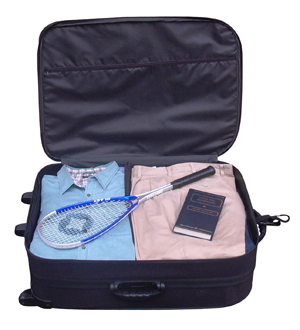We all have our own views about the personal items needed whilst away from home, but it is unquestionably beneficial to keep things as simple and as lightweight as possible. Those with experience are able to travel light and uncluttered because they know what they need. A good discipline is to note what you did not use when returning from a trip. Eventually it becomes clear what is essential and what can be left at home. Bags and cases should be tough, resilient and in reasonably sound condition. In some parts of the world suitcases may be thrown from an aircraft cargo door onto concrete twelve feet below. Strong webbing straps prevent cases bursting open. Each item of baggage should have two secure identification labels in case one is lost, and additional adhesive labels fixed inside. Before departure check the weight of all your bags against the airline's allowances. Excess baggage may be charged at 1% of the first class fare per excess kilogram.
 |
| Public domain image by Adam Ciesielski - freeimages.com |
Photographic equipment for a trip also needs careful consideration and packing in the light of objectives and the type of images you hope to obtain. Take the items needed but don't try to include everything "just in case". A bag that is too heavy soon saps energy and enthusiasm. Checklists may seem rather formal, but are a very practical way to make sure essential items are not left at home. Pilots use them on every flight because familiarity leads to error, so why not travel photographers?
Valuable photographic gear is best carried as hand baggage. When travelling by air this means using a single bag of specified dimensions limited to something like 5 - 18 kilograms in weight (depending upon the airline and class of travel). Less valuable items, like tripods and reflectors go in checked bags. When hand baggage gets overweight, one camera may sometimes be worn around the neck (although this is becoming less acceptable even in remote parts of the world) and less valuable items like flashguns, lens hoods and filters transferred to checked bags. They are likely to survive if wrapped in clothes and placed at the centre of a hard case. Films should be carried as hand baggage in transparent polythene bags, or lead-lined x-ray bags, so they are easily inspected. Memory cards should be kept in hand baggage or even in pockets.
Numerous other items can be worth taking, but much depends on the destination. Universal bath plugs are invaluable in the thousands of hotels worldwide that don't seem to have them. A Swiss Army knife (in checked baggage), a Leatherman survival tool (in checked baggage), and plastic adhesive tape for minor repairs are all useful. A couple of lengths of cord and disposable plastic sacks for dust and water protection are also often find a use. Notebooks, pencils and a small digital voice recorder aid record keeping, and guidebooks, maps and a compass are useful for navigation. Other odds and ends may be added for particular destinations. Instruction manuals for sophisticated items of equipment can also be useful when problems arise.
Customs regulations in some countries specify a maximum amount of photographic equipment and film that can be imported, but this is rarely checked and the arrival of digital photography has in any case rendered such restrictions less relevant. If challenged be prepared to point out that you have no video equipment and, if possible, that you are carrying film for other people. It also helps to show a photographic society membership card and explain that you are a keen amateur photographer. Produce an itemized list of equipment with serial numbers, and offer to have this checked upon exit. The official suspicion may be that you are a journalist or intend selling expensive equipment in the country. The last line of defence is to say how stunningly beautiful the country is expected to be - flattery and courtesy never do any harm.
It is possible to have bags shrink-wrapped or covered in paper. This makes any interference obvious and hence reduces the risk of theft. In some areas of the world it may be worth using a padlock and a 5mm diameter tailor-made steel cable around checked hard bags. This makes them impossible to force open without inflicting significant damage, so dishonest baggage handlers tend to look elsewhere. However unusual measures such as these attract the attention of customs officials and you are more likely to be pulled aside for baggage inspection.






